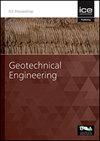虹吸孔间距对软土排水效果的影响分析
IF 1.7
4区 工程技术
Q3 ENGINEERING, GEOLOGICAL
Proceedings of the Institution of Civil Engineers-Geotechnical Engineering
Pub Date : 2022-12-14
DOI:10.1680/jgeen.22.00145
引用次数: 1
摘要
由于软土虹吸排水中的虹吸现象,地下水在没有任何动力的情况下从软土中排出,从而增加了土壤中的有效应力。排水效果的很大一部分是由虹吸孔间距决定的。根据本研究的模型试验,虹吸孔间距越小,地下水位下降越明显。与单孔试验相比,0.4 m的井距增大了107.6%。通过后续数值模拟发现,当孔距减小到1.0 m时,第60天的地下水位下降可以达到渗透系数为10 ~ 9 m/s的软土的10 m极限值。此外,现场试验表明,井距为0.9 m时,平均水位下降幅度比井距为1.8 m时大75.9%,达到相同水位下降所需时间缩短63.6%。本文章由计算机程序翻译,如有差异,请以英文原文为准。
Analysis of the influence of siphon hole spacing on soft soil drainage effect
As a result of the siphon phenomenon in soft soil siphon drainage, groundwater is discharged from the soft soil without any power, and this increases the effective stress in the soil. A significant part of the drainage effect is determined by the spacing of the siphon holes. According to the model test presented in this study, the decrease in the groundwater level is more pronounced when the spacing of the siphon holes is smaller. In comparison to the single-hole test, the spacing of 0.4 m is 107.6% larger. Based on subsequent numerical simulations, it has been found that when the hole spacing is reduced to 1.0 m, the decrease in the groundwater level on the 60th day can reach the limit value of 10 m for soft soil with a permeability coefficient of 10−9 m/s. In addition, the field test indicates that the average decrease in the water level of the 0.9 m hole spacing is 75.9% greater than that of 1.8 m, while the time required to reach the same decrease in the water level is 63.6% shorter.
求助全文
通过发布文献求助,成功后即可免费获取论文全文。
去求助
来源期刊
CiteScore
4.40
自引率
4.50%
发文量
68
审稿时长
3 months
期刊介绍:
Geotechnical Engineering provides a forum for the publication of high quality, topical and relevant technical papers covering all aspects of geotechnical research, design, construction and performance. The journal aims to be of interest to those civil, structural or geotechnical engineering practitioners wishing to develop a greater understanding of the influence of geotechnics on the built environment.

 求助内容:
求助内容: 应助结果提醒方式:
应助结果提醒方式:


